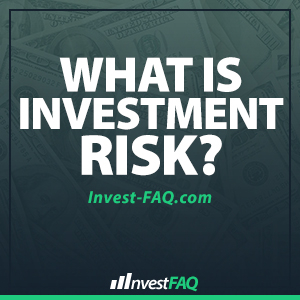 What is Investment Risk
What is Investment Risk
Risk, in general, is the possibility of sustaining damage, injury, or loss. This is true in the world of investments also, of course. Investments that are termed “high risk” have a significant possibility that their value will drop to zero.
You might say that risk is a measure of whether a surprise will occur. But in the world of investments, positive as well as negative surprises happen. Sometimes a company’s revenue and profits explode suddenly and the stock price zooms upward, a very pleasant and positive surprise for the stockholders. Sometimes a company implodes, and the stock crashes, a not very pleasant and decidedly negative surprise for the stockholders.
Because investments can rise or fall unexpectedly, the primary risk associated with an investment (the market risk) is characterized by the variability of returns produced by that investment. For example, an investment with a low variability of return is a savings account with a bank (low market risk). The bank pays a highly predictable interest rate. That interest rate also happens to be quite low. An internet stock is an investment with a high variability of return; it might quintuple, and it might fall 50% (high market risk).
The standard way to calculate the market risk of investing in a particular security is to calculate the standard deviation of its past prices. So, the academic definition is:
market risk = volatility = StdDev(price history)
However, it has long been noticed that the standard deviation may not be appropriate to use in many instances. Consider a hypothetical asset that always goes up in price, in very small and very large increments. The standard deviation of the prices (and returns) for that asset may be large, but where is the market risk?
For practical purposes (trading and system evaluation), a much better measure of market risk is the distribution of the drawdowns. Given the history of the prices, and assuming some investment strategy (be it buy-and-hold or market timing), what is the maximum loss that would have been suffered? How frequent are the losses? What is the longest uninterrupted string of losses? What is the average gain/loss ratio?
Other risks in the investment world are the risk of losing purchasing power due to inflation (possibly by making only risk-free investments), and the risk of underperforming the market (of special concern to mutual fund mangers). Occasionally you may see “liquidity risk” which basically means that you might need your money at a time when an investment is not liquid; i.e., not easily convertible to cash. The best example is a certificate of deposit (CD) which is payable in full when it matures but if you need the money before then, you will pay a penalty.
Bond holders face several risks unique to bonds, the most prominent being interest rate risk. Because the price of bonds drops as the prevailing interest rates rise, bond holders tend to worry about rising interest rates. Other risks more-or-less unique to bonds are the risk of default (i.e., the company that issued the bond decides it cannot pay the obligation), as well as call (or prepayment) risk. What’s that last one? Well, in a nutshell, a bond issuer can call (prepay) the bond before the bond matures, depending of course whether the terms and conditions associated with the bond allow it. A bond that can be repaid before the maturity date is called “callable” and a bond that cannot is called “non callable” (see the basics of bonds article elsewhere in this FAQ for more details). Hmm, you might be saying to yourself, the bond holder got the money back, where’s the risk? Because the investor will have to reinvest the money at some random time, the risk is that the investor might not be able to find as good of a deal as the old bond.
Market risk has additional components for investments outside your home country. To the usual volatility of the markets you have to add the volatility of the currency markets. You might have great gains, but lose them when you swap the foreign currency for your own. Other risks (especially in emerging markets) are problems in the economy or government (that might lead to severe market declines) and the risk of illiquidity (no one is buying when you want to sell).
This seems like a good place to discuss the classic risk-reward tradeoff. If we use volatility as our risk measure, then it’s clear an investor will obtain only modest returns from low-volatility (low-risk) investments. An investor must put his or her money into volatile (i.e., risky) investments if he or she hopes to experience returns on investment that are greater than the risk-free rate of return.
Different individuals will have very different tolerances for risk, and their tolerance for risk will change during their lifetimes. In general, if an investor will need cash within a short period of time (and will be forced to sell investments to raise that cash), the investor should not put money into high-volatility (i.e., high-risk) vehicles. Those investments might not be worth very much when the investor needs to sell. On the other hand, if an investor has a very long time horizon, such as a young person investing 401(k) monies, he or she should seriously consider choosing investments that offer the best possibility of good returns (i.e., investments with significant historical volatility). The long period of time before that person needs the money offers an unparalleled chance to allow the investment to grow; the occasional downturn will most likely be offset by other gains. All things being equal, it’s reasonable to expect that a young worker will tolerate more risk than a retired person.
A commonly accepted quantification of market risk is beta, which is explained in the FAQ article on beta.
Article Credits:
Last-Revised: 15 Aug 1999
Contributed-By: Chris Lott, Eugene Kononov
